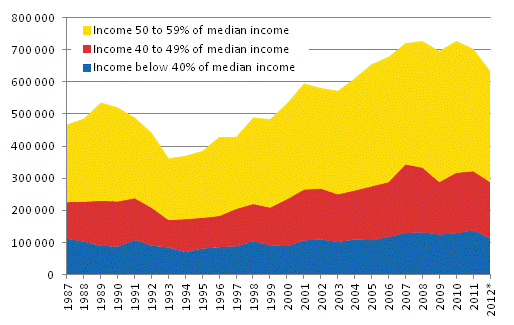Published: 20 December 2013
Number of people at risk of poverty decreased in 2012
According to the preliminary data of Statistics Finland's Income distribution statistics, the number of persons at risk of poverty decreased by around 70,000 in 2012. In 2012, approximately 635,000 persons belonged to households whose disposable monetary income per consumption unit was below 60 per cent of the national average income. The at-risk-of-poverty rate was 11.9 per cent, which was 1.3 percentage points lower than in 2011.
Number of persons at risk of poverty, 1987 to 2012*

*The data concerning 2012 are preliminary.
Households' median income and the at-risk-of-poverty threshold calculated based on it, as well as the median income of persons at risk of poverty have remained in real terms roughly at the same level in the past few years, only the number of persons at risk of poverty has decreased. The at-risk-of-poverty threshold was EUR 13,990 in 2012.
At-risk-of-poverty rate decreased in all age groups last year apart from those aged 25 to 34, whose poverty risk remained unchanged. When examining the time after 2005, poverty risk of those aged 65 or over has particularly decreased. Poverty risk among those aged 75 or over decreased most clearly. Poverty risk is, however, still highest among people aged 75 or over and under 25. Under 18-year-old children belonging to low income households as a proportion of all under 18-year-olds was 9.4 per cent in 2012 (11.1 per cent in 2011).
The at-risk-of-poverty rate also decreased compared with 2011 when using tighter income criteria. There were around 290,000 persons whose household's disposable monetary income per consumption unit was lower than 50 per cent of the equivalent median monetary income of all households in 2012. In the previous year, there was 325,000 such persons. ( Database table 5a .)
When asked whether the household's income is sufficient to cover normal expenses, fewer low income households than before had difficulties making their ends meet. The assessments concerning the sufficiency of income among other households also improved to some degree. ( Database table 5d. )
Persistent risk of poverty described by the total statistics on income distribution also declined by 0.3 percentage points in 2012. The drop was clearest among the population aged 65 or over, and especially among women. Persistent risk of poverty among elderly persons has slowly declined since 2008 by several percentage points. The persistence of poverty risk is measured with an indicator that depicts income in a four-year period. Poverty risk is persistent if a household's equivalent income is less than 60 per cent of the median income at least twice during this period, in addition to the statistical reference year. ( Database table 9 of the total statistics on income distribution .)
Source: Income Distribution Statistics 2012, preliminary data, Statistics Finland
Inquiries: Hannele Sauli 09 1734 3497, Kaisa-Mari Okkonen 09 1734 3408
Director in charge: Riitta Harala
- Tables
-
Tables in databases
Pick the data you need into tables, view the data as graphs, or download the data for your use.
Updated 20.12.2013
Official Statistics of Finland (OSF):
Income distribution statistics [e-publication].
ISSN=1799-1331. Income inequality (international comparison) 2012. Helsinki: Statistics Finland [referred: 28.12.2025].
Access method: http://stat.fi/til/tjt/2012/01/tjt_2012_01_2013-12-20_tie_001_en.html

